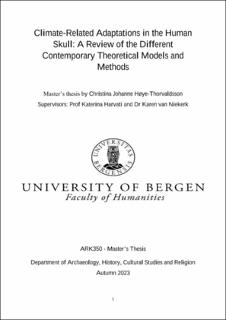Climate-Related Adaptations in the Human Skull: A Review of the Different Contemporary Theoretical Models and Methods
Master thesis
Permanent lenke
https://hdl.handle.net/11250/3109939Utgivelsesdato
2023-11-20Metadata
Vis full innførselSamlinger
- Master theses [240]
Sammendrag
Questions regarding our ancestral species have always appealed to our curious side. Our first ancestral species lived in arboreal settings before gradually adapting to a more open, terrestrial environment. It can be observed in the fossil record that hominins began to show a greater degree of adaptations towards anatomical traits that would be beneficial in such environments. Significant changes can be seen as hominins migrated out of Africa and were subsequently exposed to different climates and ecological niches. Accordingly, gaining further knowledge about these climate-related adaptations is of prime interest for understanding the context from which our ancestors emerged and evolved. However, to understand these events it is important to develop useful theoretical frameworks which can aid researchers in tying such links between human morphological variation and climate. Theoretical frameworks are used to make sense of data and more focus must be on developing such frameworks. The conclusion of this thesis is that there are only two theoretical frameworks that can be useful to climate adaptation research: modern evolutionary theory and the ecological rules of Bergmann and Allen. However, more in-depth theoretical models are needed to bridge the gap between morphological variation and climate. This study will present theoretical models and methods, compare and discuss these theoretical frameworks and methodologies, and investigate any consistencies in the use of theories within the field. This thesis also aims to critically analyse and highlight the limitations of the discipline by addressing present issues. The final aim and purpose of this thesis is to better understand the need and significance of well-built theoretical frameworks and methods in achieving a better understanding of the links between climate and morphological variation.
